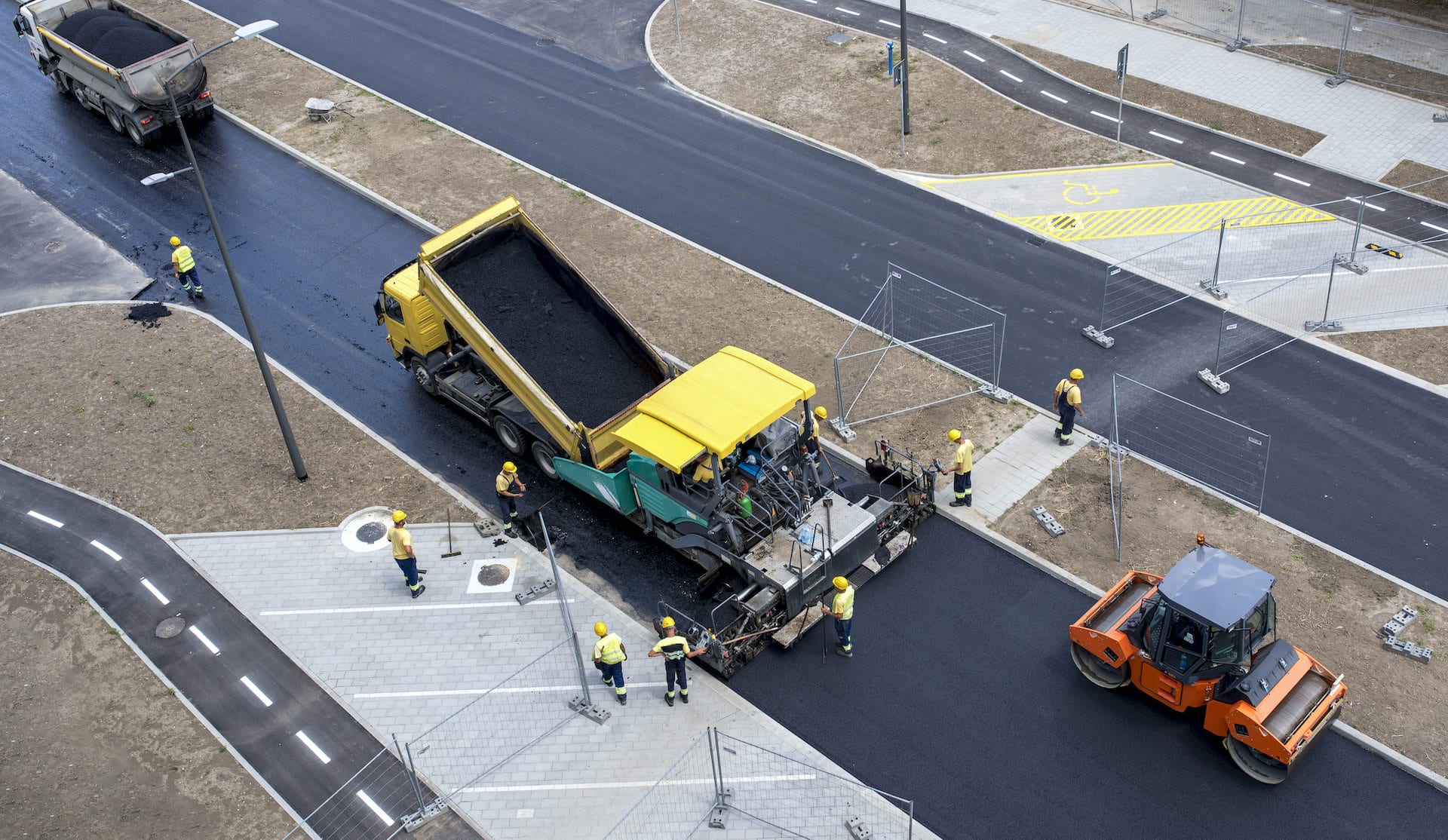
Autodesk recently held a webinar about how DOTs and other government agencies are innovating when it comes to infrastructure construction. The host, Jen Jewett joined Autodesk Construction Solutions after a 13-year career at the Montana Department of Transportation (MDT). In Jen’s role as Innovations Project Manager at MDT she had the unique opportunity to work with cross-discipline teams to develop workflows and enable DOT survey, design, and construction staff to adopt newly implemented technology; advancing the DOT toward their Digital Delivery Initiative and e-Construction goals.
Jen was joined by Jesus Sandoval, PE, Construction Liaison Engineer at New Mexico DOT (NMDOT) and Dakota Clifford, eConstruction Lead at Virginia DOT (VDOT). They spoke on several topics, ranging from championing innovation within a large government agency, earning federal funding for new construction technology, creating, running and scaling pilot programs statewide, and improving remote productivity during the COVID-19 pandemic.
This is an incredibly exciting time for DOTs. There are so many opportunities to receive funding to explore new technology and turn that exploration into a way they can save time and money in construction.
For instance, the Federal Highway Administration (FHWA) incentivizes DOTs to incorporate digital technology in construction. In April 2012, the FHWA established the Center for Accelerating Innovation (CAI) to serve as the focal point for internal and external coordination to identify and prioritize innovations.
Since the inception of Every Day Counts (EDC), a state-based model that identifies and deploys proven, yet underutilized innovations, each state has used 19 or more of the 52 promoted innovations, and some states have adopted more than 40. Many of these innovations have become mainstream practices across the country. EDC-6 was recently announced which includes Digital As-Builts.
The STIC Incentive Program offers up to $100,000 per STIC, per year. The total AID Demonstration Grants Funds Awarded is now over $60 million! AID Demonstration funding can cover up to the full cost of the innovation in the project, to a maximum of $1 million.
Virginia can be seen as a model for fostering innovation within a large government agency. VDOT is intentional about establishing an ecosystem where new ideas can germinate before applying them statewide. As a result, the agency partners closely with University of Virginia (UVA) and created the Virginia Transportation Research Council. Within VDOT, there is a research council funded primarily from state and federal money. Having this centralized research arm with a dedicated budget means they can allocate funds and prioritize projects based on what can have the highest impact. This is super important for fostering innovation. While VDOT must focus on building, maintaining, and operating roads and highways, they also have a semi-autonomous organization that can focus on cutting edge technology without the same mandates of VDOT.
With strong ties to academia, VDOT essentially includes an incubator within the agency. This allows them to explore new technology – like their own an R&D branch. With the research council as the connection between VDOT and UVA, there’s an established pipeline of ideas and talent. Of course, many DOTs have R&D teams and they recruit from local universities, but Virginia was intentional about establishing these relationships with an emphasis on research.
During the webinar, Jesus provided an overview of a successful pilot project using tablets in the field. The project was an ADA improvement project located in Artesia, NM on US 82. It included curb & gutter, curb ramp, sidewalk, driveway reconstruction and traffic control devices for pedestrians during construction in an urban area.
“This project allowed us to test many different features in PlanGrid. NMDOT used the software to document daily work reports (DWRs), traffic control, RFI submittals, project documentation, plan sheet revisions, pictures & video, and much more,” said Jesus.
“Once inspectors got comfortable documenting DWRs including pictures, it played a big role when making field decisions. For traffic control documentation, it enabled the contractor and inspectors to work closely, communicate, and monitor traffic control devices daily. This was a huge win for us.”
Measuring return on investment is important for DOTs. From this pilot, NMDOT learned that an inspector saves about 1.78 hours per day by doing DWRs in the field from a tablet. Additionally, the project was completed 15 days ahead of schedule. According to Jesus, “The total savings in time and what we would have spent in post construction plans is about $31K which in itself, saved the department close to $20K and this is not including paper printouts.
As NMDOT plans to implement PlanGrid statewide, savings are expected to add up to a $75,000 per year, per project office. If the technology is rolled out to our 200 inspectors, this could easily save the agency nearly $4 million over the next 3 years.
Virginia DOT piloted PlanGrid for about 18 months. They identified eight teams in eight different districts, covering more than 50 projects and 75 participants. As part of the research paper for the FHWA, VDOT conducted in-person interviews with project staff. VDOT learned that inspectors were spending on average four to five more hours per week on their jobsites. That's an extra 10% to 15% of their time that they're spending on their jobsites.
Dakota noted, “We also saw that they were taking an additional 16 photos per week, per person on the job. Which is a huge, huge boost to our ability to report on what's happening on our projects and manage our documents. So, we were very, very excited about that.” This not only shows that inspectors were engaging more with the technology, but they were capturing valuable project data directly from the field. This is important information that allows the DOT to make informed decisions quickly, and they’re included in the digital as-built at the end of the project.
Starting in January of 2020, VDOT launched tablet based inspections statewide. They now have 306 active projects, 450 internal users, and more than 300 consultant and contractor users on board. After VDOT trained hundreds of inspectors and construction staff on the use of the tool and got the contract procured and in place, they then equipped everybody with iPads.
So how did VDOT scale its use of PlanGrid to over 300 projects in just 18 months? First, they conducted user testing. This might sound like a design thinking concept, but it’s important for working out any kinks. Again, this is where the VDOT Research Council is super valuable. By testing on a small scale, VDOT got valuable insights from users, and can identify additional uses as well as the strengths and limitations of the new technology.
After user testing, VDOT standardizes best practices. In this phase, the team creates the foundation to scale the programs and identify champions. Internal buy-in is huge. Having a few power users, champions or internal experts will help the technology catch on in the beginning stages when it is most risky. From then, it will continue to spread before it reaches a critical mass.
Once the team lays the groundwork, they begin the process of scaling statewide. To do this, the team determines their rollout strategy and shifts their focus from a test and learn approach to implementation. This takes time and it’s a continuous process. But because of the work up front, the team is confident in their foundation to expand throughout the agency and to all contractors and consultants.
Many leaders in infrastructure construction are seizing the opportunity presented by fewer cars on the roads and they are actually accelerating their projects and adoption of new technology. With COVID impacting everyone, it has pushed departments to implement or try new tools. This includes web-based meetings, electronic construction management, and cloud services.
With new COVID protocols and distancing measures in place on jobsites, teams need to rely more on remote collaboration tools. COVID is an accelerant and we’re seeing many agencies rise to this challenge, such as NMDOT and VDOT. DOT projects are mostly horizontal in rural areas. For an inspector, to drive back to the office to do their DWRs or to pick up a revised plan sheet, it’s anywhere from a 30-minute to an hour drive one way. Using PlanGrid, inspectors reduce the time they spend in an office updating their daily work reports and as a result, they spend more time in the field while maintaining social distancing. It makes it so much easier for contractors and inspectors to submit RFIs and paperwork without having to drive to the office.
“With COVID, adoption of cloud based and mobile solutions will accelerate. Just having updated field information relatively available, it makes it easier for people working from home to do their job without going to field. Especially on our massive roadway jobs,” said Jesus.
“Not only that, but we’re seeing reduced traffic due to sheltering in place and working from home. This allows us to fast track some of our roadway projects," Jesus continued.
“When you combine this opportunity with the need to collaborate remotely, we think this is a moment in the construction industry, especially in infrastructure construction, where we’re going to see an acceleration of the use of mobile and cloud technology.”
Both VDOT and NMDOT have accomplished a lot in terms of technology innovation and implementation in the last couple of years. At VDOT, an innovation policy ensures that they change the process and use off-the-shelf software as much as possible as a means to implement. Instead of building customized software around their process, they adapt their process instead of totally customizing the software to the point that it no longer functions correctly.
In addition to moving forward with the adoption of new technology and mobile devices for design submittals, NMDOT is also increasing investment in document management. By storing documents, plans and specs in one location, they plan to cut down on working off bad data and duplicate information. By combining the digital document management with field execution, they will collaborate more effectively in the cloud. This will allow NMDOT to work from the same information and communicate more seamlessly between office and field and with contractors, as well as collect valuable project data from the field throughout the life of the job.
Overall, the adoption of new technology allows for better partnering between DOTs contractors, and other stakeholders by increasing transparency of contract documentation transmission, distribution, and storage, while saving time and money in a paperless environment. Dakota concluded, “Technology is intended to make the lives easier of the people using it. Allow your engineers to engineer, and your inspectors to inspect. Give your people the tools to do their jobs and get out of their way.”

May we collect and use your data?
Learn more about the Third Party Services we use and our Privacy Statement.May we collect and use your data to tailor your experience?
Explore the benefits of a customized experience by managing your privacy settings for this site or visit our Privacy Statement to learn more about your options.